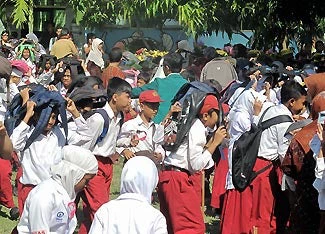 |
| Children participate in an earthquake drill. |
Available in Bahasa
I recently attended the Asian Minister's Conference on Disaster Risk Reduction where protecting schools, hospitals, students and patients from natural disasters was firmly on the agenda. The conference provided a great opportunity for country representatives across the region to come together and share their experiences of making schools and hospitals safer places during and after disasters.
Indonesia, given its central position in the 'ring of fire' was an appropriate place to hold the conference. While many statistics were offered up during the conference I couldn’t get out of my head one presenter's estimate that Indonesia had a staggering five seismic events every day. The city hosting the conference, Yogyakarta, was hit by a devastating earthquake in 2006 where 6,000 people lost their lives, 900 schools were completely destroyed and a further 1,200 severely damaged. Beyond the loss of life and physical damage, the disruption to children’s schooling and the psycho-social impact of such a terrifying experience is immeasurable and goes largely unreported.
Communities in Yogyakarta have not sat around idly since the earthquake struck. As part of the conference we were taken to Bantul which was at the center of the earthquake and lost over 90% of its education facilities. The madrasah we visited had completely collapsed and the disruption to children's lives was considerable. Fortunately, the earthquake hit when children were not in the school but the principal told me that it caused severe disruption to school life with many lessons having to take place in tents. The school community vowed to be better prepared in the future and rebuilt classrooms to be more resistant to seismic shocks and developed a comprehensive plan to ensure that children knew what to do if disaster struck again. The enthusiasm and comprehensiveness of the drills they showcased demonstrated why they had won third prize in an Asian-wide disaster preparedness competition.
The story of the madrasah reflects efforts across Indonesia to improve school infrastructure and introduce disaster planning into schools. With support from the World Bank, GFDRR and the Basic Education Capacity Trust Fund, the Government of Indonesia has begun a pilot project in three provinces which retrofits classrooms during routine rehabilitation to make them more resilient. The pilot project has also supported disaster preparedness training for thousands of children in project schools. While the program is in its pilot stages it appears to have struck the right balance between structural and non-structural elements of disaster preparedness.
The pilot program is a significant step in the right direction but there is still a long way to go to strengthen the approximately 100 thousand schools in disaster risk areas and protect the 12 million students studying in them. Prioritizing areas most at risk and extending the reach of pilots of this kind is vital if the devastation and substantial costs associated with post-disaster reconstruction are to be avoided in the future.
The Government of Indonesia signaled its commitment to making schools and hospitals safer places during the conference. A special session hosted by the Minister of Education and Culture and Vice Minister of Health highlighted eloquently what was at stake and the conference declaration emphasized the need to support local efforts for safe schools and hospitals. Millions of students and teachers across the region will be hoping that the declaration will translate into effective action that will protect them during times of crisis.
[[avp asset="/content/dam/videos/ecrgp/2018/jun-2/disaster_preparedness_starts_young_hd.flv"]]/content/dam/videos/ecrgp/2018/jun-2/disaster_preparedness_starts_young_hd.flv[[/avp]]


Join the Conversation